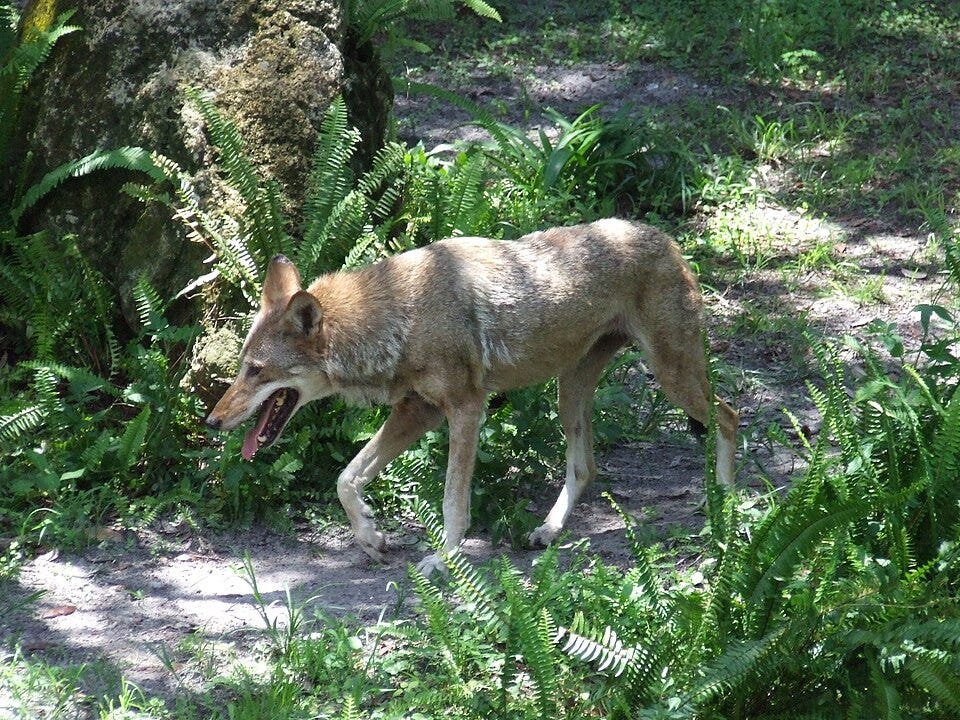One wolf to bring them back, one wolf to guide them,
One wolf to carry hope — and in the wild, revive them. *
As climate change accelerates biodiversity loss, scientists and biotech companies are exploring radical new tools to preserve—or even restore—species. Among them is a high-profile effort to bring back something resembling the legendary “dire wolf.” I wrote about it here. ut beyond the headlines, quieter—and arguably more impactful—work is being done to save real wolves from extinction.
The wolf, long a symbol of power and mystery in both myth and nature, has played a vital role in shaping the world around us. In Turkish culture, the bozkurt—the grey wolf—is revered as a guide: a spiritual force that leads, protects, and restores balance. Similarly, among many Indigenous peoples of North America, wolves are respected as wise teachers, pathfinders, and kin — often seen as models of loyalty, cooperation, and resilience. The Pawnee saw the wolf as a symbol of the warrior spirit, while the Nehiyawak (Cree) and Diné (Navajo) traditions include stories of wolves as protectors and companions. In Mongolian and Siberian shamanic traditions, the wolf is also a powerful totem animal associated with protection and ancestral connection.
Today, this ancient symbol feels more relevant than ever as the fight to save endangered species and restore ecosystems takes centre stage. One of the most fascinating examples of this is the ongoing effort to save the red wolf.
Dire Wolves and Scientific Hype
The public’s attention has been captured by the so-called “dire wolves”—a species brought to life through genetic engineering by Colossal Biosciences. But fewer people have heard of the critically endangered red wolf, native to the southern United States.
The buzz around dire wolves may seem like science fiction, and rightly so. These three animals aren’t resurrected dire wolves; in fact, no dire wolf DNA was used. They are genetically engineered grey wolves, altered to resemble what we believe dire wolves once looked like—based on skeletal evidence and artistic reconstruction.
Let that sink in. As far as current science can tell, we don’t have enough preserved material to know with certainty—not beyond skeletal structure. Colouration, fur texture, behaviour—those are still speculative. And we know that true dire wolves and grey wolves could not interbreed, one reason dire wolves eventually disappeared.
Colossal’s branding clearly leans into mythology—but would they have received the same attention if they didn’t play into the fantasy and fables of dire wolves? Probably not. And honestly, I’m not one to condemn them for that. As for the three engineered animals, their purpose is entirely experimental. They will live out their lives in closed, controlled reservations, never to be released into the wild, to prevent their engineered genes from mixing with natural populations.
Critics argue this is just marketing. And they’re not wrong—the name “dire wolf” taps into pop culture and mythology more than it does evolutionary reality. But this spectacle has achieved something remarkable: it opened new scientific doors and drew in public and financial support that’s helping us save real, living species.
From Fiction to Conservation
That includes the red wolf. While the dire wolves are experimental, the technology and tools developed through their creation have made the red wolf project possible. Unlike their white-coated cousins, these wolves will be released into the wild, as part of a bold effort to save a species on the brink of extinction.
Red wolves have faced a dangerous genetic bottleneck. The dwindling population, already small, has been shrinking in genetic diversity, putting them at risk of collapse. The work now underway will inject new, carefully engineered genetic variation into the population, helping combat inbreeding and increase resilience.
This isn’t about building super-wolves. It’s about giving a vulnerable species the biological tools it needs to survive.
Memory and Balance
I first became captivated by wolves as a student in Colorado in the 1990s. That’s when I read about the reintroduction of wolves into Yellowstone National Park. It was controversial at the time. But years later, the now-famous videos of “trophic cascade”—how wolves reshaped entire ecosystems—showed the incredible, healing power of bringing back an apex predator.
They changed not only the behaviour of deer, but the shape of riverbanks and the growth of trees. They restored balance. It was unforgettable.
Now, we may be seeing the next chapter in that story. Colossal’s work on genetic restoration—controversial though it may be—is helping create tools that give us a fighting chance. Not just to marvel at ancient creatures, but to help living ones.
A Warning and a Hope
There’s a risk here too: that de-extinction might become an excuse. That we lull ourselves into thinking extinction isn’t permanent because science can always “bring them back.”
That would be a dangerous lie.
What we should be striving for is healthy ecosystems, not technological life support. Still, in cases like the red wolf—where extinction isn’t yet final—these tools might mean the difference between survival and silence.
Following the Bozkurt
The wolf, whether in legend or in the wilderness, continues to guide us. In Turkish myth, the bozkurt led the people to safety and rebirth. In Yellowstone, wolves led an entire ecosystem back to life.
Today, perhaps they are leading us too—toward a more responsible and hopeful way of living with the natural world.
The question is: will we listen?
*And yes, this is my clumsy nod to the Lord Of The Rings, a series I fell in love with first time I read it in 7th grade!





